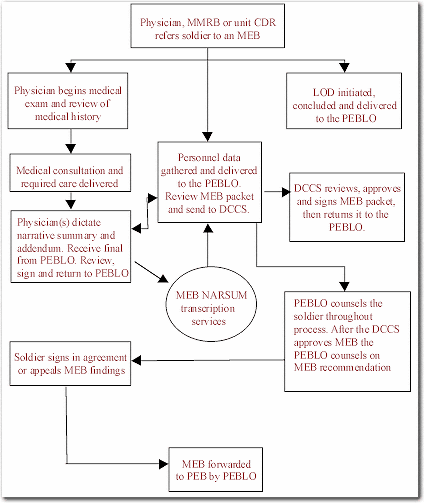
|
|
The MEB Explained
On this page you will find a basic explanation of the process, a Flowchart highlighting the numerous steps and players, and required elements to complete a MEB packet
What is a Medical Evaluation Board?
A MEB is an informal proceeding consisting of at least two physicians evaluating the medical history of a soldier and determining how the injury/disease will respond to treatment protocols. During the course of the MEB, physicians refer to medical fitness standards contained in AR 40-501, chapter three (1998). The regulation lists various medical conditions and physical defects that may render a soldier unfit for military duty.
To the left is flowchart illustrating the steps involved with processing a MEB case. Some of the steps may be repeated due to the difficulty of a case or requests for more information. The DOD sets an allowable time for processing MEB cases at 30 days.
What determines if a person is fit or unfit for duty? According to
DODD 1332.18 (1996), the sole standard for making determinations of unfitness due to physical disability is based on ability to perform the duties of the service member's office, grade, or rank because of disease or injury. This is where the process begins.Following the diagram, the physician examines the soldier, initiates necessary consults from other departments, orders a complete physical, and reviews the soldier's medical history. The Clinical information collected must include "a medical history, appropriate physical examination, medical tests and results, all consultations, diagnoses, treatment and prognosis" (DODI 1332.38, 1996, E3.P1.2.3). To ensure standardization, physicians who prepare MEBs are encouraged to use the Department of Veterans Affairs' Physician's Guide for Disability Evaluation Examinations to indicate the nature and degree of severity of the soldier's condition.
Once all of the necessary activities are complete, the physician dictates the narrative summary (NARSUM). This NARSUM is typed and sent through the PEBLO for review. The PEBLO checks the NARSUM for completeness and accuracy then sends the NARSUM to the dictating physician. The physician reviews the NARSUM and if he believes it is accurate, signs it and returns the document to the PEBLO.
The PEBLO is responsible for case management of the soldier. PEBLOs annotate significant dates and assist soldiers in getting medical appointments. They are the first to know if the process has slowed or halted. Throughout the process the PEBLOs keep soldiers informed and communicate with the soldier's unit. When the PEBLO has a complete MEB packet, he takes the case to the Deputy Commander for Clinical Services (DCCS) for review. The DCCS is the final approving authority on the MEB case and must signify his approval before the packet goes to the Physical Evaluation Board (PEB). Once the PEBLO receives the approved MEB case from the DCCS, he counsels the soldier on the findings. If the soldier agrees, he signs and the case is sent to the PEB.
What is Required in a MEB Packet
MEB packets submitted to the PEB must include a complete narrative summary of the case. In reaching any conclusions, physician(s) must consider all medical examination evidence, medical history, results of x-rays and laboratory tests, reports of consultations, and responses to therapy. More than just medical information is required to complete a MEB packet. As described below, several requirements must be met by the servicing personnel center and the unit commander.
As outlined in
DODI 1332.38 (1996), MEB packets forwarded to the PEB shall include the following information: